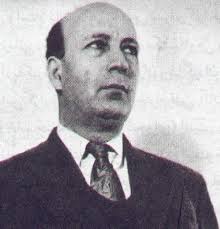Khalil Maleki facts for kids
Quick facts for kids
Khalil Maleki
|
|
|---|---|
 |
|
| Born | 1901 |
| Died | 13 July 1969 (aged 67–68) Tehran, Pahlavi Iran
|
| Political party |
|
Khalil Maleki (Persian: خلیل ملکی; 1901–1969) was an important Iranian political thinker. He was a socialist, meaning he believed in a society where everyone is more equal. He was also connected to the National Front, a group that wanted Iran to be independent and democratic.
Contents
Khalil Maleki: A Political Leader
Early Political Life and the Tudeh Party
In the early 1940s, Khalil Maleki was one of 53 thinkers who were put in prison by Reza Shah, the ruler of Iran at the time. After he was set free, Maleki helped start the Tudeh Party. This party was communist and supported the USSR (Soviet Union). They wanted Iran to become a socialist country like the Soviet Union.
The Tudeh Party worked hard to help workers. They organized protests and pushed for better pay and living conditions. This was especially important for oil workers in Khuzestan. However, many Iranians thought the Tudeh Party was taking orders from Soviet leader Joseph Stalin. Because of this, some people saw them as disloyal to Iran.
Standing Up for Iran's Independence
Over time, Maleki started to believe that the Tudeh Party was controlled by the Soviet Union. He decided to leave the group and began to speak out against them. He then helped create the Toilers Party of Iran with Dr. Mozzafar Baghai. This new group aimed to bring socialism and democracy to Iran. It was also strongly against communism.
Maleki believed Iran should be free from the influence of both the West (like Great Britain) and the East (like the Soviet Union). He wanted Iran to be truly independent.
Supporting Prime Minister Mossadegh
In 1952, Maleki disagreed with Baghai. Baghai decided to oppose the government of Dr. Mohammad Mossadegh. Mossadegh was the prime minister and leader of Iran at that time. In 1951, he had led the effort to nationalize the oil industry. This meant Iran took control of its own oil, rather than it being controlled by foreign companies.
Mossadegh also worked to make Iran more democratic. He brought about some changes in government, the military, and how elections were held. Baghai, however, thought Mossadegh was too soft on communists. He also felt Mossadegh's policies were too focused on collective ownership.
Because of this disagreement, the Toilers Party split. One part joined Baghai in opposing Mossadegh. The other part joined Khalil Maleki in supporting Mossadegh's policies. This group became known as the Third Force. It was a major left-wing group within the National Front.
Life After the 1953 Changes
On August 19, 1953, the Iranian military, who supported the Shah, removed Mossadegh from power. The new ruler, Mohammad Reza Shah, created a more controlling government that favored the West. Khalil Maleki and other nationalists strongly opposed this new government.
Maleki continued his political work throughout the 1950s and 1960s. He joined the Third National Front and remained active in politics until he passed away in 1969.
What Maleki Believed In
Maleki was a Marxist, which means he followed the ideas of Karl Marx about society and economics. He had been a Communist earlier in his life. He was one of the first Communist leaders in the world to disagree with Stalin after World War II.
Later, in the 1950s and 1960s, Maleki supported democratic socialism. This idea combines socialist goals with democratic freedoms. He also believed in the non-aligned movement. This movement was for countries that did not want to take sides with either the United States or the Soviet Union during the Cold War.
In the offices of the Third Force party, there was a picture of Jawaharlal Nehru. Nehru was a leader from India, and Maleki felt a strong political connection to him. Maleki hoped that Iran could achieve peaceful change through elections. However, the Shah's strict rule in the late 1960s made those hopes difficult to achieve.

